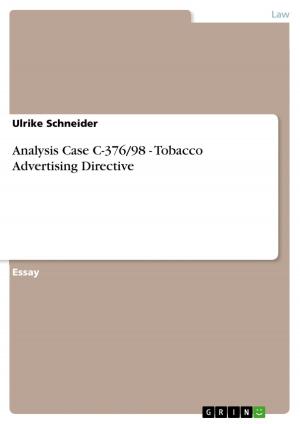Guideline to increase efficiency of E-Mail communication within projects
Business & Finance, Marketing & Sales| Author: | Pascal Naue, Oliver Möller | ISBN: | 9783640671250 |
| Publisher: | GRIN Publishing | Publication: | July 28, 2010 |
| Imprint: | GRIN Publishing | Language: | English |
| Author: | Pascal Naue, Oliver Möller |
| ISBN: | 9783640671250 |
| Publisher: | GRIN Publishing |
| Publication: | July 28, 2010 |
| Imprint: | GRIN Publishing |
| Language: | English |
Seminar paper from the year 2010 in the subject Business economics - Marketing, Corporate Communication, CRM, Market Research, Social Media, grade: 1,3, University of Applied Sciences Essen, language: English, abstract: The usage of E-Mails as a rather new means of communication has increased steadily since its inception in 1971. Whether for private or business matters, the increasing im-portance and coherently high amount of E-Mail communication can be problematic: Important information gets lost in too much communication. Especially for project management, due to limited time and resources as well as having the right information at the right time shared with the right persons, it has become vital to use E-Mails efficiently. Therefore the inherent question is, what efficient E-Mail communication is and how it can be increased in project management? Most of the recent literature about project management does not provide an integrated guide considering communicational aspects in project management and classic commu-nication theories. Furthermore none of the project management literature is focusing on e-mail communication in particular. This paper has the objective to provide a guideline to increase efficiency of E-Mail communication in projects by integrating communicational aspects of the project man-agement theory and of the general communications theory. The objective is therefore not to create a handbook for a universally applicable E-Mail. Due to the length restrictions of this paper intercultural influences are not considered. To allow a better understanding of the guideline it is necessary to reach a common un-derstanding of the theories underlying. Therefore the paper is separated into a theoreti-cal and a practical part: The objective of the theoretical part is to create a common understanding of the theories used for the creation of the guideline: As two different areas of theory are used, the theoretical part is carried out in two parts as well: The first one explains the 'communi-cation square' by Schulz von Thun. The communication model by Schulz von Thun delivers an explanation on how different layers of communication generally influence the communication itself. The second one is a consolidation of selected literature on project management: The project management theories provide a framework for communication within pro-jects with special regard to the objectives and key aspects of communication in projects. The objective of the practical part is to conclude both theories into an integrated guide-line: The claim of this guideline is to create an understanding of how the different elements of an E-Mail can affect its efficiency.
Seminar paper from the year 2010 in the subject Business economics - Marketing, Corporate Communication, CRM, Market Research, Social Media, grade: 1,3, University of Applied Sciences Essen, language: English, abstract: The usage of E-Mails as a rather new means of communication has increased steadily since its inception in 1971. Whether for private or business matters, the increasing im-portance and coherently high amount of E-Mail communication can be problematic: Important information gets lost in too much communication. Especially for project management, due to limited time and resources as well as having the right information at the right time shared with the right persons, it has become vital to use E-Mails efficiently. Therefore the inherent question is, what efficient E-Mail communication is and how it can be increased in project management? Most of the recent literature about project management does not provide an integrated guide considering communicational aspects in project management and classic commu-nication theories. Furthermore none of the project management literature is focusing on e-mail communication in particular. This paper has the objective to provide a guideline to increase efficiency of E-Mail communication in projects by integrating communicational aspects of the project man-agement theory and of the general communications theory. The objective is therefore not to create a handbook for a universally applicable E-Mail. Due to the length restrictions of this paper intercultural influences are not considered. To allow a better understanding of the guideline it is necessary to reach a common un-derstanding of the theories underlying. Therefore the paper is separated into a theoreti-cal and a practical part: The objective of the theoretical part is to create a common understanding of the theories used for the creation of the guideline: As two different areas of theory are used, the theoretical part is carried out in two parts as well: The first one explains the 'communi-cation square' by Schulz von Thun. The communication model by Schulz von Thun delivers an explanation on how different layers of communication generally influence the communication itself. The second one is a consolidation of selected literature on project management: The project management theories provide a framework for communication within pro-jects with special regard to the objectives and key aspects of communication in projects. The objective of the practical part is to conclude both theories into an integrated guide-line: The claim of this guideline is to create an understanding of how the different elements of an E-Mail can affect its efficiency.















